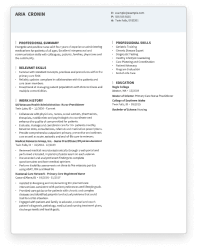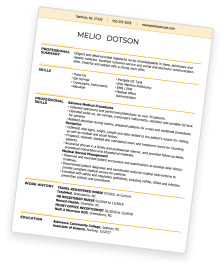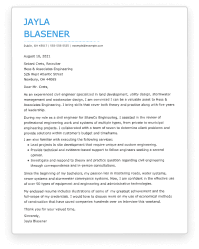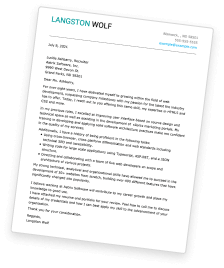Cook Resumes: Overview
As a cook, your role is essential in culinary operations, ensuring that delicious, high-quality food is served to patrons. Your responsibilities are varied and encompass much more than just preparing dishes.
They include understanding recipes, ingredient preparation, cooking techniques, kitchen safety, and cleanliness standards, contributing to menu development, and working efficiently under pressure to ensure timely service.
Cooks find opportunities in a diverse range of settings, such as:
- Restaurants and Bars
- Hotels and Resorts
- Fast Food Chains
- Catering Services
- Private Households and Personal Chef Services
- Food Trucks and Pop-Up Kitchens
Crafting an outstanding resume is a critical step towards landing your next position as a cook.
Our expertly curated resume examples and downloadable templates are designed to help you effectively present your qualifications and passion for cooking, making you a standout candidate in the culinary world.
Cook Resume: Choose A Format
Crafting a resume as a cook starts with selecting the right template and format. It’s essential to choose a resume format that not only highlights your culinary skills and experience but also captures the attention of hiring managers in a competitive field.
There are three primary resume formats that cooks can use: chronological, functional and combination.
Chronological Resumes For Cooks
The chronological resume format is highly favored for cooks with a solid track record of professional kitchen experience.
This layout lists your work history in reverse chronological order, emphasizing your progression in the culinary field.
For each position held, you should include:
- Job Title and Employer: Clearly state your position and the name of the establishment.
- Dates of Employment: Indicate the period you worked in each role.
- Responsibilities and Achievements: Use bullet points to detail your duties and highlight significant contributions or achievements. Focus on specifics that demonstrate your cooking skills, ability to work under pressure, teamwork, and any specializations within the culinary arts.
Incorporate action verbs that convey your role in the kitchen and quantify your achievements when possible, such as by noting improvements in service efficiency, contributions to menu development, or recognition for your culinary creations.
Chronological resumes are especially useful for demonstrating a steady career progression and are easily navigable by Applicant Tracking Systems (ATS), making your resume more likely to be seen by potential employers.
Functional Resumes For Cooks
Functional resumes are skill-focused, making them an excellent option for cooks who might not have a traditional career progression but possess a strong set of culinary skills.
This format is particularly beneficial for those entering the culinary field from another career, recent culinary school graduates, or cooks with extensive freelance or part-time experience.
In a functional resume, emphasize:
- Culinary Skills: Highlight your expertise in specific cooking techniques, cuisines, or types of cooking (e.g., pastry, grilling).
- Kitchen Management: Include skills related to inventory management, kitchen safety standards, and staff supervision if applicable.
- Adaptability: Demonstrate your ability to quickly adapt to different kitchen environments and work under pressure.
While functional resumes allow you to focus on your strengths, remember that some hiring managers and ATS systems may prefer the more traditional chronological format. To counteract this, consider including a concise work history section that provides context for your skills.
Combination Resumes For Cooks
The combination resume format offers the best of both worlds, blending the detailed skill focus of the functional resume with the clear career progression of the chronological resume.
This format is ideal for cooks who have a mix of direct kitchen experience and transferable skills from other roles or extensive expertise in specific areas of cooking.
Start with a skills section where you can elaborate on your culinary abilities, then follow with a chronological work history that includes your roles, employers, and dates of employment.
This approach allows you to first impress potential employers with your skills, then back them up with solid evidence of your experience.
Combination resumes are particularly effective for cooks looking to highlight their well-rounded experience and specializations within the culinary arts, making them a compelling choice for those aiming to advance in their culinary careers.
Choosing a Format
Selecting the most suitable resume format is a crucial step in the resume writing process for cooks.
The chronological format is often recommended for those with a clear, linear career progression in cooking or culinary arts. This format allows you to showcase a solid history of kitchen experience, emphasizing growth and development in culinary roles.
However, if your journey to becoming a cook has been less straightforward, don’t discount the value of diverse experiences. Skills gained from other types of jobs, such as teamwork, customer service, and time management, are highly transferable to the culinary field.
If you’re a recent culinary school graduate or have varied experiences across different roles, a functional or combination resume might serve you better.
Ultimately, the best resume format for you is one that presents your qualifications in the most compelling and coherent way. Consider how each role and experience has contributed to your development as a cook and choose a format that best tells your professional story.
How To Write A Cook Resume
Once you’ve selected the right format for your cook resume, outlining it involves including several key sections.
These are essential for showcasing your culinary skills, experience, and suitability for the kitchen role you’re aiming for.
The five critical sections to writing a resume are:
- Contact Information
- Summary or Objective
- Work History
- Skills
- Education
You can also add additional sections to further expand your qualifications, such as awards and volunteer experience.
Each section plays a crucial role in presenting you as a well-rounded candidate, ready to take on the challenges of a professional kitchen.
Contact Information
Your contact information should be clear and accessible, providing potential employers with easy ways to reach out to you. This section includes:
- Full Name
- Phone Number
- Professional Email Address
- Location (city/state)
- LinkedIn Profile/Online Portfolio (if applicable)
Ensure this information is placed at the top of your resume, formatted to be noticeable without overpowering the rest of the document’s content.
For example, your contact information on your cook resume might look like this:
Chris Thompson
Austin, TX
chris.thompson@fake.email.com
(555) 987-6543
Portfolio: fake.chrisculinarycreations.com
Summary or Objective
Following your contact information, your cook resume should feature a section that succinctly introduces you to the hiring manager. Depending on your experience level and career goals, you can opt for either a resume summary or an objective.
Resume Summary: Best suited for cooks with substantial professional experience, a summary provides a brief overview of your culinary skills, key achievements, and professional aspirations. It’s an excellent way to immediately showcase your value to potential employers.
Example of a resume summary on a cook resume:
“Passionate and skilled Cook with over 5 years of experience in high-volume kitchens. Specializes in Italian and Mediterranean cuisine, with a proven track record of improving customer satisfaction through creative menu development and food presentation. Known for excellent time management and efficiency, consistently delivering high-quality dishes under pressure.”
Resume Objective: Ideal for those new to the culinary field or seeking a career change, an objective focuses on your ambitions and how you aim to grow and contribute as a cook. It’s an opportunity to highlight your enthusiasm and potential.
Example of a resume objective on a cook resume:
“Dedicated and dynamic individual with a strong foundation in culinary arts, seeking to leverage comprehensive training from Culinary Institute X to excel as a Cook at Restaurant Y. Eager to apply knowledge of international cuisines and bring fresh, innovative dishes to the table, while learning and growing under the mentorship of esteemed chefs.”
Whichever option you choose, ensure it’s tailored to reflect the job you’re applying for, incorporating relevant keywords and phrases from the job posting.
This not only helps your resume to pass through Applicant Tracking Systems but also aligns your application with the employer’s expectations, improving your chances of securing an interview.
Work History
The “Work History” section is essential for cooks to demonstrate their culinary skills, experiences, and the value they’ve brought to past kitchen teams.
It’s crucial to list your roles in reverse chronological order, beginning with your most recent position, to give potential employers a clear view of your professional journey.
Focus on roles that are most relevant to the cooking position you’re targeting, and use strong action verbs to describe your responsibilities and achievements.
Where possible, quantify your accomplishments to provide tangible evidence of your impact in the kitchen. This could include improvements in service efficiency, contributions to menu innovation, or commendations for your culinary creations.
The work history section of your cook resume may look something like this:
Line Cook
Rustic Table Bistro, Portland, OR
June 2019 – Present
- Played a key role in a kitchen team that achieved a 30% increase in diner satisfaction scores through menu innovation and improving service efficiency.
- Led the implementation of a waste reduction initiative that cut kitchen waste by 25%, aligning with sustainability goals.
- Developed and executed a series of popular seasonal specials, contributing to a 20% increase in average customer spend.
- Maintained high standards of kitchen hygiene, passing all health inspections with no deficiencies.
By clearly outlining your work history, focusing on the specifics of your role, responsibilities, and the positive outcomes of your contributions, you paint a picture of a dedicated, skilled, and results-driven cook.
This section is your opportunity to showcase the depth of your culinary experience and the positive impact you’ve had on previous employers.
Skills
In the skills section of your cook resume, it’s crucial to highlight the hard and soft skills that demonstrate your culinary expertise and your ability to thrive in a kitchen environment.
This section complements your work history, providing a snapshot of your technical capabilities and interpersonal skills that are most relevant to the position you’re applying for.
Here are some of the most popular hard skills and soft skills to consider:
Top 5 Hard Skills for Cook Resumes
- Culinary Techniques: Proficiency in a range of cooking techniques, from baking to grilling, is fundamental for any cook.
- Food Safety and Hygiene: Knowledge of food safety standards and hygiene practices is essential to ensure the health and safety of patrons.
- Menu Development: Experience in creating and adapting menus to meet dietary needs and preferences can set you apart.
- Inventory Management: Skills in managing kitchen inventory efficiently to minimize waste and reduce costs.
- Kitchen Equipment Operation: Familiarity with the operation and maintenance of kitchen equipment, from stoves to industrial mixers.
Top 5 Soft Skills for Cook Resumes
- Time Management: The ability to manage your time efficiently, ensuring that dishes are prepared and served promptly.
- Teamwork: Working effectively as part of a kitchen team is crucial for the smooth operation of any culinary establishment.
- Stress Management: Maintaining composure and delivering high-quality work under the pressure of a busy kitchen.
- Creativity: Bringing creativity to dish presentation and recipe innovation to enhance the dining experience.
- Adaptability: Being able to quickly adapt to changes in menu, kitchen environment, or customer preferences.
An example of the skills section on a cook resume may look like this:
Skills
- Advanced knowledge of French and Italian cuisine techniques
- Certified in food safety and hygiene practices
- Experienced in seasonal menu planning and development
- Proficient in inventory management software and techniques
- Skilled in the operation of high-volume kitchen equipment
- Excellent time management and teamwork capabilities
- Creative in recipe development and plate presentation
By showcasing a well-rounded set of skills, you communicate to potential employers that you are not only technically capable but also possess the soft skills necessary to excel in dynamic and sometimes challenging kitchen environments.
Education
The education section of your cook resume is an opportunity to highlight your culinary training and any formal education that supports your cooking career.
List your highest degree first, followed by any culinary degrees or certifications, including the institution’s name, its location.
Graduation date, elevant coursework, honors, or special certifications related to cooking or food safety can also be included here.
Here’s an example of what the education section on a cook resume can look like:
Culinary Arts Diploma
Institute of Culinary Education, New York, NY
Note: While formal culinary education is beneficial, many cooks also learn through apprenticeships, on-the-job training, or self-teaching. If your educational background is not directly related to cooking, consider emphasizing how it has contributed to your skills as a cook—such as a degree in business management enhancing your understanding of restaurant operations.
Additional Sections
Consider including additional sections in your resume if they offer further insight into your qualifications and interests as a cook. These can differentiate you from other candidates by showcasing a broader range of experiences, skills, or achievements.
Additional sections include:
- Certifications
- Volunteer Experience
- Professional Associations
- Awards and Honors
- Relevant Hobbies
For example, you may have additional sections on your cook resume such as:
Certifications
- Certified Culinarian (CC), American Culinary Federation, 2021
- Food Handler’s Card, State of New York, 2020
Awards
- First Place, NYC Culinary Challenge, March 2021
By tailoring these sections to reflect your unique experiences and achievements, you provide a fuller picture of your capabilities and character as a cook.
Top 5 Certifications for Cooks
While not always mandatory, certain certifications can enhance a cook’s resume by validating their culinary skills and commitment to food safety and quality.
These certifications can set you apart in a competitive job market and demonstrate your readiness to take on responsibilities in a professional kitchen.
Some valuable certifications for cooks include:
- ServSafe Food Handler Certification: Offered by the National Restaurant Association, this certification is crucial for understanding food safety practices and is often a basic requirement for kitchen staff.
- Certified Culinarian (CC) by the American Culinary Federation (ACF): This entry-level certification for cooks showcases a foundation in culinary skills and is a stepping stone for further professional development.
- ProChef Certification: Offered by the Culinary Institute of America, the ProChef certification tests culinary, baking, and pastry skills at different levels, recognizing a cook’s expertise and dedication to the craft.
- HACCP (Hazard Analysis Critical Control Point) Certification: This certification focuses on food safety management and is valuable for cooks in settings where understanding and managing food safety risks are critical.
- Certified Sous Chef (CSC) by the American Culinary Federation: For cooks aiming to advance their careers, this certification demonstrates an elevated level of skill, knowledge, and leadership in the kitchen.
11 Tips For Writing a Cook Resume
Tailor Your Resume: Customize your resume for each culinary position, emphasizing the skills and experiences that align with the specific requirements of the job posting.
Use Action Verbs: Employ dynamic verbs such as “prepared,” “designed,” “managed,” or “innovated” to describe your contributions in the kitchen vividly.
Highlight Achievements: Whenever possible, quantify your culinary achievements with figures, such as percentages related to cost reduction, increases in customer satisfaction, or improvements in kitchen efficiency.
Incorporate Keywords: Scan the job listing for important keywords related to culinary skills, kitchen equipment, or specific cuisines, and include these terms in your resume to enhance its ATS compatibility.
Demonstrate Versatility: Show a range of culinary skills and experiences, from expertise in specific cuisines to adeptness in various kitchen roles, to portray yourself as a well-rounded candidate.
Emphasize Teamwork: Kitchens thrive on collaboration, so highlight your experience working effectively as part of a culinary team, including any leadership roles or initiatives you’ve taken.
Detail Your Education and Training: Include formal culinary education, workshops, or certifications that contribute to your cooking skills, especially those that are relevant to the job you’re applying for.
Showcase Certifications: List any professional certifications that validate your cooking skills and knowledge, such as ServSafe or Certified Culinarian, to reinforce your qualifications.
Mention Special Skills: If you have unique skills or interests, such as baking, butchery, or sustainable cooking practices, make sure to include these to set yourself apart from other candidates.
Include Voluntary Experiences: Participation in culinary competitions, volunteer work, or pop-up kitchen events can provide additional proof of your passion and skill in cooking.
Proofread: A resume free from typos and grammatical errors is crucial in demonstrating your attention to detail, an essential trait for any cook.
Helping Job Seekers Like You
View Similar Resumes
- Executive Chef Resume
- Sushi Chef Resume
- Cook Resume
- Restaurant Assistant Manager Resume
- Restaurant Manager Resume
- Baker Resume
- Dishwasher Resume
- Pastry Chef Resume
- Prep Cook Resume
- Line Cook Resume
- Kitchen Manager Resume
- Restaurant General Manager Resume
- Chef Resume
- Fast Food Manager Resume
- Sous Chef Resume


Use Hloom's Resume Builder
Key Takeaways
- A cook’s resume should highlight a broad range of culinary skills and specializations, from expertise in specific cuisines to proficiency with various cooking techniques and kitchen equipment.
- Opting for a chronological format can effectively showcase your career progression and development as a cook, emphasizing your experience and achievements in professional kitchens.
- Including your culinary education, along with any certifications such as ServSafe or Certified Culinarian, underscores your commitment to the culinary arts and adherence to industry standards.
- Soft skills like teamwork, time management, and adaptability are crucial in a kitchen environment. Highlight these skills to show you can thrive in fast-paced, collaborative settings.
- Customize your resume to align with the job description, using keywords and focusing on the specific skills and experiences that match the employer’s needs, to enhance your chances of getting noticed.
Use Hloom's Cover Letter Builder














